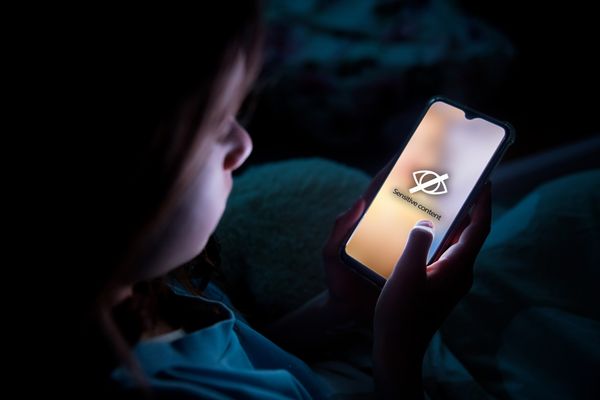The sun beats down on Sarah Jenkins' right shoulder as her daughter lifts her into a sling chair next to the pool.
Her hands curl and grip the poles as she is hoisted into the air and swung around. Her toes find the water first, then her ankles, then all but her green eyes submerge below the surface.
Except for the green noodle she uses to support her arms, Sarah swims unaided. It is the one time she can move alone.
"The most important thing I can do is swim every day ... I think swimming basically saved my life," she says.
Sarah moves from one side of the pool to the other, each footstep slow but deliberate. She grabs the side for extra support.
As she walks, she gets what feel like "zaps" up her leg. "It doesn't happen for the majority of the day," she says. "[Swimming] just gives me the most amazing feeling and sensation, because you're stimulating the nerves."
It's that feeling of freedom that led Sarah to find her new passion — drone photography — at the height of lockdown.
"What's funny is that I can't take a photo with any other apparatus," she says.
"I can't use a standard camera and I can't use a mobile phone — I can't hold it up."
Getting the diagnosis
Sarah lives with a limb-girdle muscular dystrophy called LGMD2i (also called FKRP-related LGMD R9), one of the world's rare diseases. It started to present itself in her late teens as her performance decreased when swimming.
"I thought, oh, it's just puberty, I'm just slowing down."
When Sarah started her nursing career, people would ask her why she was limping as she walked down the corridor.
"I would say I'm not limping ... people noticed it before I did," she says.
"When I was 30, I went to an aerobics class, and we all had to get on our tippy toes, and I couldn't. So I went, okay, this is weird... and that's when I started doing testing."
Only a few hundred or thousand people in Australia are thought to have LGMD2i.
"It affects your respiratory muscles, so your diaphragm and intercostal muscles that help your lungs expand and contract are weakened," Sarah says. "So my breathing is affected and usually that is what ends a person's life with muscular dystrophy. It is respiratory or cardiac failure — or both."
After she was diagnosed, Sarah fell pregnant with her first daughter Lucy and a year later, her second daughter Tess. It was during this period of her life that she started to feel a decline in her condition.
"I remember when I used to sit on the grass for picnics. And I thought, one day I'm not going to be able to get up."
That moment came in 2016, when her dog Pippa ran underneath her legs in her narrow hallway, and she broke her leg.
"From that day on, I never stood up again. I never walked. I never drove a car ... my whole life changed dramatically."
Sky-high thinking and a new sense of purpose
Drones came into Sarah's life at a time when her world was shrinking, as COVID lockdowns were closing in.
During Melbourne's long lockdown, her daughter Lucy came to live with her in Port Douglas and, together, they decided they would buy one.
"We just said, what are we going to do? We've got to do something. I couldn't really do anything in the community, because I was high risk to COVID, I was pretty much having to isolate from people," Sarah says.
She admits she was initially terrified she would crash it and didn't want to fly it herself.
"I gradually built confidence flying it, and I just saw the Earth from a different perspective."
In November 2020, Sarah organised a photo shoot inspired by COVID lockdowns and a recent artwork she had painted.
"I just got this idea of using a basketball court, just down the road, and I thought, what if I put this girl in the middle of the court, reading a magazine, supposedly having a really nice time, in the midst of this chaos that was going on in the world, making compromises to still be happy and enjoy life?"
She went and bought a pool ring and borrowed a little bag.
"It was 10 o'clock in the morning, and it was so hot," Sarah recalls of the shoot. "The poor girl had to sit on a towel underneath the pool ring, and we just had to measure out. She was in the middle of the court, and I put the drone up, and I just started shooting."
The Boston Drone Film Festival found Sarah and Lucy's picture on their Instagram page, Air Bare Studio, and asked them to enter it in their competition.
To their delight, their image won the architecture category in 2021, less than a year after they began experimenting with the drone.
"We felt a little like we didn't deserve the award as we were so inexperienced... but it gave us the confidence to enter another competition, which was Capture Magazine's Australasia's Top Emerging Photographers," Sarah says.
The same image took home that award in the Single Shot category.
An international publishing company has recently chosen 16 of Sarah and Lucy's images for their new book on minimalism in photography.
Reigniting creativity
Sarah says picking up a drone has helped reignite her creativity through a new lens.
She loved painting during school and her early adult years and has had a deep appreciation for art and design ever since.
"Photography is no different to creating a painting — it's all about composition, orientation, framing, colour and tone, and it should tell a story," she says.
"I really do love to look at things in a minimalist way... to zero in on a particular section of an image for things that are quirky and unique.
"You've got to look at things from so many different perspectives to understand the real meaning of it."
Still, she laughs: "We don't always hit the mark."
Even though Lucy is back living in Melbourne, Sarah has continued to experiment and looks forward to studying an online photography course this year.
"Photography has just made me realise that it is something I can absolutely do," she says. "The drone can take me to places that I can't physically get to and create images I ordinarily wouldn't be able to."







